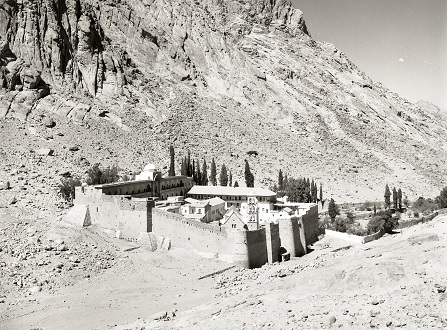The Manuscripts of St. Catherine's Monastery
Among the most fascinating treasures at the National Library of Israel is the collection of photographed manuscripts from Saint Catherine’s Monastery. Officially known as the Sacred Autonomous Royal Monastery of Saint Katherine of the Holy and God-Trodden Mount Sinai, this famous institution is located in the Sinai Peninsula, in the heart of the Sinai Desert. The monastery sits at the foot of Mount Sinai, about 8,200 feet above sea level. According to a Christian tradition originating with Helena, the mother of Roman Emperor Constantine the Great who lived in the fourth century, the monastery was built on the very spot where Moses saw the burning bush.
The library at Saint Catherine’s Monastery is considered to be the oldest working library in the world. Its activities have continued uninterrupted since the Byzantine Emperor Justinian I founded the monastery in the sixth century. This library houses a collection of over 3,300 ancient manuscripts, in addition to papyri and rare books, as well as artifacts, valuable jewelry, religious icons and more. The dry climate helped to preserve the antique manuscripts in excellent condition, and the distance from the upheavals of the world, wars and various conquerors, enabled the monastery to safeguard them from any harm.
In 1950, an American delegation from the Library of Congress set out to photograph the manuscripts and make them accessible to the public. The delegation photographed about 1,690 manuscripts in Greek, Arabic, Church-Slavonic and other languages common from the 12th century. The researchers compiled a catalog of the manuscripts, papyri and books found in the monastery. These photocopied manuscripts can be viewed on the Library of Congress website.
After the Six-Day War, in which Israel captured the Sinai Peninsula, public and academic interest in the isolated monastery and its treasures began to grow. Israeli travelers and researchers began to visit Saint Catherine’s, gaining access to its hidden treasures. In 1968, the administrators of the Hebrew University ordered the Jewish National and University Library to photocopy those manuscripts that had not been photographed by the Library of Congress delegation, approximately half the entire collection. The Israeli delegation set out for Mount Sinai and, under difficult conditions, photographed hundreds of manuscripts, which were preserved on microfilm. A new catalog of manuscripts was also compiled.
After many years, the photographed material was in danger of being lost due to the chemical decomposition of the microfilm. The National Library launched an operation to save the material and make it accessible to the public through digitization of the photographed manuscripts. Today, the manuscripts from Saint Catherine’s Monastery can be viewed on the National Library of Israel website.




